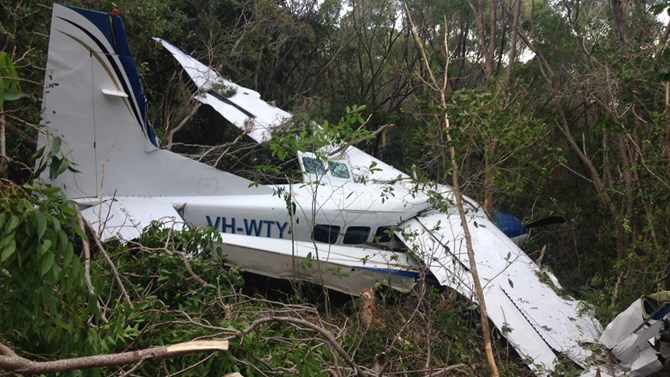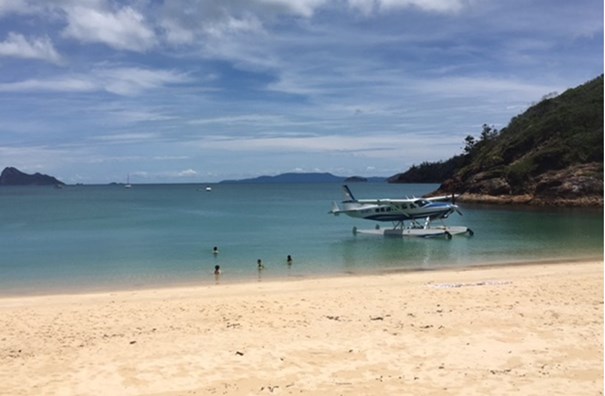How far away is death? Seaplane tour downed

What began as a seaplane tour over the Great Barrier Reef ended up as a wreck amid trees and brush.
A Cessna Caravan seaplane tour was navigating a scenic charter over the Great Barrier Reef. The aircraft clipped trees and impacted dense scrubland while attempting a go-around after an aborted water landing, according to details in a final ATSB (Australian Transport Safety Bureau) investigation report.
The aircraft was carrying 10 passengers as the pilot attempted a landing at Whitsunday Island’s Chance Bay when it bounced three times on the water after the pilot reported holding off the landing in order to fly through an observed wind gust.
Seaplane tour downed on go-around after aborted water landing

After the second bounce, with the aircraft nearing the beach . . .
The pilot increased engine power and initiated a go-around. A more pronounced third bounce, which occurred almost immediately after the second, resulted in the aircraft rebounding about 30 to 50 feet above the water.
While increasing power, the pilot perceived that the engine torque was indicating red, suggesting an engine over-torque for the selected propeller configuration. Noticing that the climb performance was less than expected with the flaps at the 30 degree setting, the pilot stopped increasing power and reduced the flap to 20 degrees.
As it climbed straight ahead toward a saddle, the aircraft’s climb performance was still below the pilot’s expectations. Assessing that the aircraft would not clear the surrounding rising terrain, the pilot turned right. However, during the turn, the aircraft clipped trees before coming to rest in dense scrub about 150 meters from the eastern end of the main beach, near the top of a ridge.
The pilot promptly advised the passengers to exit and move away from the aircraft. Some of the passengers suffered minor injuries in the accident, but all were able to leave the aircraft quickly. There was no post-impact fire, but the aircraft was substantially damaged.
What the ATSB investigation found
The ATSB found that the aircraft was flown beyond the aircraft landing area’s northern boundary before the first bounce off the water. This, combined with the delay in initiating a go-around, reduced the options and margins available for a safe outcome.
The engine operating limitations contained in the float operations pilot-operating handbook supplement were also not consistent with other publications and may have influenced the power level applied by the pilot during the go‑around.
What’s been done as a result
The float manufacturer-published pilot operating handbook supplement was amended with respect to engine operating limits. The operator advised they have taken action to enhance or update existing procedures as well as checklists for their float plane operations.
Safety message
Charter seaplane operations present unique challenges, particularly in relation to the water landing environment. Variable sea conditions and the possibility of sharing the landing area with marine vessels and people mean that every landing has the potential to be markedly different.
A go-around is a normal procedure and a safe option whenever landing conditions are not satisfactory. However, it is important to consider aircraft performance and local conditions when planning an escape route, including conducting “mental rehearsals” of standard procedures. In addition, making an early decision to conduct a go-around significantly reduces the associated risk.
This accident report is ATSB investigation number AO-2016-007, Collision with terrain involving Cessna 208 Caravan, VH-WTY, 11 km north-east of Hamilton Island Airport, Queensland on 28 January 2016.
Read the full ATSB report.
Founded in 1988, the TapRooT® Root Cause Analysis System solves hurdles every investigator faces
TapRooT® Root Cause Analysis Training System takes an investigator beyond his or her knowledge to think outside the box. Backed with extensive research in human performance, incident investigation, and root cause analysis, TapRooT® is a global leader in improved investigation effectiveness and productivity, stopping finger-pointing and blame, improving equipment reliability, and fixing operating problems.
System Improvements, the creator of the TapRooT® System, has a team of investigators and instructors with years of extensive training ready to offer assistance worldwide.
TapRooT® Root Cause Analysis Training courses are taught all over the world
If you are interested in learning how to stop repeat incidents, find a 2-Day or 5-Day course; or view the complete selection of TapRooT® courses. We are available to train you and your staff on-site at your workplace; Contact us to discuss your needs. You may also call us at 865.539.2139 to discuss any questions you may have.
Keep in touch to improve your problem-solving skills
We’re continually training, helping you improve your professional root cause analysis skills. Stay current with your TapRooT® Root Cause Analysis skills and training through:
- Following our blog;
- Free newsletters;
- Tuning in to TapRooT® video sessions or our podcasts;
- Connecting with us on Facebook, Twitter, Instagram, Pinterest, LinkedIn, and YouTube;
- And our annual Global TapRooT® Summit.



